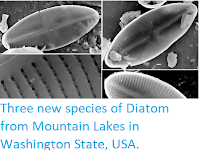Diatoms are single celled algae related to Kelp and Water Moulds. They
are encased in silica shells with two valves. During reproduction the
cells divide in two, each of which retains one valve of the shell,
growing a new opposing valve, which is slightly smaller and fits flush
within the older valve. This means that the Diatoms grow smaller with
each new generation, until they reach a minimum size, when they undergo a
phase of sexual reproduction, giving rise to a new generation of
full-sized cells.
In a paper published in the journal Phytotaxa on 6 May 2019, Christine Cocquyt of the Meise Botanic Garden, and Edit Lokele Njombo of the Faculté des Sciences at the Université de Kisangani and the Institut Facultaire des Sciences Agronomiques de Yangambi describe two new species of Diatom from the Democratic Republic of Congo and Ghana.
The first species is placed in the genus Geissleria, and given the specific name lubiluensis, meaning 'from Lubilu', in reference to the Lubilu River, a tributary of the Congo in which it was discovered; the Lubilu lies within the Yangambi Biosphere Reserve in Tshopo Province of the Democratic Republic of Congo, and the species is described based upon specimens collected from the river during a series of biological surveys of the region in 2015, in the Lubilu, Lokombe, Lotuli, and Lukwaje rivers, all tributaries on the right bank of the Congo River downstream Kisangani.
Geissleria lubiluensis. SEM, valves from type material. (12)-(15) External views, showing the denser striae between the annuli and axial area; note the bifurcated terminal raphe ending and an open girdle band near the apex on (13). (16)–(17). Internal views. (16) Detail of the annuli. (17) Detail of the straight central raphe endings. Scale bar in (12) is 5 μm, and (13)–(17) ar all 1 μm. Cocquyt & Lokele (2019).
Geissleria lubiluensis has elongate valves with rounded ends, which range from 18.0 to 31.5 μm in length, and from 9.8 to 11.5 μm in width. The valves have an elongate grove that runs along most of the centre of the long axis, though this has a break in the middle and does not reach the ends. Much of the remainder of the surface is covered by rows of striae (small indentations), though again there is a break in the central part of the valve.
The second species described was discovered as the result of a study of previously collected Diatoms of the genus Geissleria made while determining that Geissleria lubiluensis was in fact a new species. The species is named Geissleria fogedii, in honour of Niels Foged, who first described the specimens from which the species is described in 1966. Foged identified the specimens as belonging to the species Geissleria paludosa, though after re-examining the specimens Cocquyt and Lokele conclude that this is a new species.
Geissleria fogedii. (18)–(22). Valve views from type material of Foged, Ghana, showing the size diminution series. (23). SEM. Inside view of valve showing the details of the striae and annuli near one pole. Scale bar in (18)–(22) are 10 μm, and in (23) is 1 μm. Cocquyt & Lokele (2019).
Geissleria fogedii was originally described from the River Suhin, a tributary of the Tain, which in turn flows into the Black Volta, though Cocquyt and Lokele also identified a valve possibly belonging to the species in the Lubilu River in the Democratic Republic of Congo, which suggests the species might be quite widespread. Geissleria fogedii is similar to Geissleria lubiluensis, but reaches only 21.8 to 23.5 μm in length and 8.3 to 9.2 μm in width.
See also...
Follow Sciency Thoughts on Facebook.








